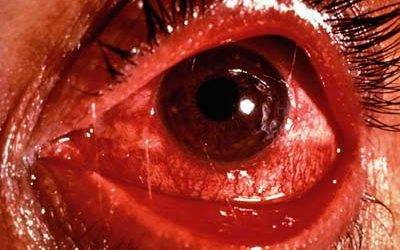Over recent months, conjunctivitis has been plaguing sections of the country, but from all indications the situation is farther reaching.
This is according to information issued by the Trinidad and Tobago-headquartered Caribbean Public Health Agency [CARPHA]. According to CARPHA, several Caribbean islands have reported outbreaks of conjunctivitis at health facilities and medical practices. As such, CARPHA has issued a ‘red eye’ alert for the Caribbean Region.
Conjunctivitis refers to inflammation of the membrane covering the whites of the eyes and the inside of the eyelids. The congestion of blood vessels in this membrane gives rise to a reddened appearance and explains the more common names “red eye or pink eye”.
The most common causes of conjunctivitis are viruses, bacteria, and allergens. Viral and bacterial conjunctivitis are very contagious and can spread easily from person to person.
“The Caribbean Public Health Agency (CARPHA) is currently monitoring the situation and we want to urge persons to take the necessary precautions to prevent and reduce the spread of this illness,” said Dr. Virginia Asin-Oostburg, CARPHA’s Director of Surveillance, Disease Prevention and Control.
Eye symptoms can include: redness; irritation; itchiness; production of excessive tears; clear or yellow discharge that may make the eyelids stick together, especially in the mornings and swelling of the eye lids.
But the risk of getting conjunctivitis or spreading it to someone else can be reduced.
As such, CARPHA has advised members of the public to practice some simple good, hygiene steps including: avoid close contact with persons who are ill with conjunctival symptoms; keep unwashed hands away from face and eyes; wash your hands often with soap and warm water.
Alternatively, persons may use an alcohol based hand-sanitizer; avoid sharing personal items, such as pillows, washcloths, towels, eye drops, eye makeup, face makeup, makeup brushes, contact lenses and, contact lens containers, or eyeglasses and disinfect frequently-touched surfaces in common areas, (for example doorknobs and counter-tops in shared spaces).
According to information out of CARPHA, individuals who are infected should altogether avoid using makeup and applicators, (for example brushes and sponges). Also, if infected, persons should wash hands well before and after cleaning, or applying eye drops or ointment into their infected eye[s].
Once the infection goes away, it is important to avoid re-infection by: discarding disposable contact lenses and cases used while the infection persisted; discarding extended wear lenses or, at the least, sterilise as directed by an eye-care professional. It is also advisable that following an infection an individual’s eyes are examined by an eye care professional before beginning to use contact lenses again. Persons are also encouraged to clean eyeglasses and cases that were used while infected.
CARPHA in its advisory has urged persons to access more information on the condition from their local health clinics or their general practitioner.
Here in Guyana an increase of ‘red eye’ since earlier this year was recorded at a number of health facilities across the country. In commenting on the situation, Deputy Chief Medical Officer [DCMO], Dr. Karen Boyle, described it as a seasonal viral infection. She acknowledged that while reports of an increase of the condition are factual, the situation had not reached worrying proportions.
There were, however, confirmed reports that several health facilities, both private and public, t were hard-pressed to treat the condition.
Checks by this publication had revealed that some health facilities had no treatment to offer to a number of patients afflicted with the condition. They were however reportedly urged to check at privately-operated pharmacies where they could purchase treatment. Checks at several pharmacies were also met with claims that treatment was not available.
When this state of affairs was put to the DCMO, she disclosed it was not at all inconceivable that this had occurred. She however informed that while she was not in possession of all of the facts, it is possible that while there may be a shortage of treatment at some locations, it is likely that there are others that have ample supplies.(Kaieteur News)
- Home
- News
- Views
- Opinion
- Editorial
- Features
- Clinical
- Regions
- Anguilla
- Antigua and Barbuda
- Bahamas
- Barbados
- Belize
- Bermuda
- British Virgin Islands
- Cayman Islands
- Dominica
- Grenada
- Guyana
- Jamaica
- Montserrat
- Saint Kitts and Nevis
- Saint Lucia
- Saint Martin
- Saint Vincent and the Grenadines
- Saint-Barthélemy
- Trinidad and Tobago
- Turks and Caicos Islands
- US Virgin Islands














